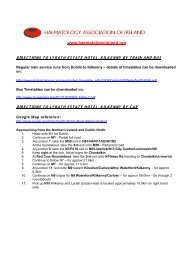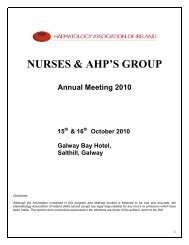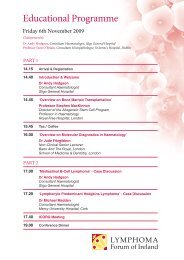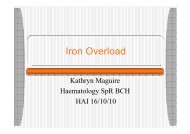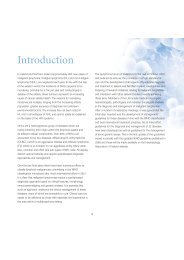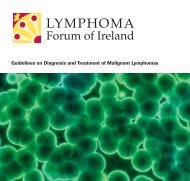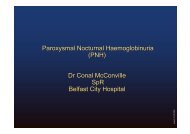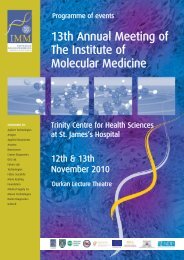Gary Benson - Haematology Association of Ireland
Gary Benson - Haematology Association of Ireland
Gary Benson - Haematology Association of Ireland
Create successful ePaper yourself
Turn your PDF publications into a flip-book with our unique Google optimized e-Paper software.
Overview <strong>of</strong> ITPDr <strong>Gary</strong> <strong>Benson</strong>Director N <strong>Ireland</strong> Haemophilia Comprehensive Care Centreand Thrombosis CentreBelfast City Hospital
Idiopathic (Immune)Thrombocytopenic Purpura• Thrombocytopenia in the absence <strong>of</strong> otherblood cell abnormalities (normal RBC &WBC, normal blood film)• No clinically apparent conditions ormedications that can account forthrombocytopenia
Statistics <strong>of</strong> ITP• Incidence <strong>of</strong> 22 /million/year in one study• Prevalence greater as <strong>of</strong>ten chronic*Segal et al 100 /million/year*age-adjusted prevalence 9.5/100,000*1.9 :1 females / males
Clinical Manifestations• May be acute or insidious onset• Mucocutaneous Bleeding*petechiae, purpura, ecchymosis*epistaxis, gum bleeding*menorrhagia*GI bleed, CNS bleed = RARE
Aetiology <strong>of</strong> ITP : Children• Maternal associated• Often after infection (viral or bacterial)– Post MMR vaccination• Theories:*antibody cross-reactivity*H. pylori*bacterial lipopolysaccharides
Aetiology <strong>of</strong> ITP : Adults• ?? Auto-antibodies?
Diagnosis (<strong>of</strong> Exclusion)• Rule out other causes:*lab error / PLT clumping*drug / medication interaction*infections (HIV, Hepatitis C)*thyroid / autoimmune disease*destructive / consumptive processes (TTP/HUS)*bone marrow disease (leukemias, MDS)
Diagnosis (<strong>of</strong> Exclusion)• Rule out other causes:*lab error / PLT clumping*drug / medication interaction*infections (HIV, Hepatitis C)*thyroid / autoimmune disease*destructive / consumptive processes (TTP/HUS)*bone marrow disease (leukemias, MDS)
To Marrow or Not to Marrow?• Bone marrow aspiration & biopsy if…• Patient 60 yrs. or older• Poorly responsive to tx• Unclear clinical picture
Anti-Platelet Antibody Testing• NOT recommended by BSH PracticeGuidelines• Poor positive/negative predictive values,poor sensitivity with all current testingmethods…• …and doesn’t change the management!
Management <strong>of</strong> ITP in Adults• Emergency vs. Chronic Tx• Goal = prevention <strong>of</strong> bleeding, NOT cure!
Management <strong>of</strong> ITP in Adults• Emergency vs. Chronic Tx• Goal = prevention <strong>of</strong> bleeding, NOT cure!
General Principles <strong>of</strong> Therapy• Major bleeding rare if PLT > 10,000• Goal = get PLT count to safe level toprevent bleeding…•…not to specifically cure the ITP!
“Safe” Platelet Counts• “moderately” t-penic = 30-50,000• Probably safe if asymptomatic• Caution with elderly (CNS bleeds)
When Planning Therapy…• Tailor therapy and decision to treat to theindividual patient• Weigh bleeding vs. therapy risks
Initial Therapy• Prednisolone 1 mg/kg/day*usual response within 2 weeks• Taper <strong>of</strong>f after PLT response• Duration <strong>of</strong> use = controversial
Second-Line Therapy• IV Immune Globulin (IVIg)1 gram/kg/day x 2 days• anti-D – if pt is Rh+50-75 mcg/kg/day
Treatment Side-Effects•Steroids*bone density loss *GI effects*muscle weakness *weight gain• IVIG/anti-D*hypersensitivity *headache*renal failure *nausea/vomiting*alloimmune haemolysis
Splenectomy• Usually reserved for treatment failure• Consider risk <strong>of</strong> bleeding, pt lifestyle• RISKS*surgical procedure*loss <strong>of</strong> immune function vaccinations
Response Post-Splenectomy• Usually normalized PLTs within 2 weeks(<strong>of</strong>ten immediately)• Younger pts do better• Kojouri et al (Blood 2004) 65% CR
Data from Fabris, F, et al. Br J Haematol 2001; 112:637.
Chronic Refractory ITP• Persistent > 3 months• PLT < 50,000• Failure to respond to splenectomy
When all else fails…• Steroids• IVIg / anti-D• Rituximab (anti-CD20)• Cyclophosphamide• Danazol• Accessory splenectomy• H. pylori eradication
ITP and Health-Related QOLMean SF-36 ScoresSF-36 Domains and Component Summary Scales• Patients with ITP have worse QOL than the generalpopulation and patients with common disorders• ITP QOL is better than CHF or missing or paralyzed limbMcMillan R, et al. Am J Hematol. 2008;83(2):150-154.
Pathophysiology <strong>of</strong> ITPOAPOAutoantibodyProductionPlateletOpsonizationAPDDPlateletDestructionPPlateletProductionPTCT-Cell–MediatedCytotoxicityTCCines DB, Blanchette VS. N Engl J Med. 2002;346:995-1008.
Mechanism-Based Approaches toTreatment• Inhibit phagocyte-mediated clearance <strong>of</strong> Ab-coated platelets– Steroids– Splenectomy– Anti-D– IVIG• Decrease antibody production– Rituximab– Steroids– Azathioprine and other immunosuppressants (eg, cyclophosphamide,cyclosporine, mycophenolate m<strong>of</strong>etil)• Impair T and B cell interactions– Steroids– Rituximab– Other immunosuppressants• Enhance platelet production– Thrombopoietic agents– Interleukin 11
Thrombopoietin Levels in ITP25025Platelet Count (x 10 3 /µl)200150100502015105Serum TPO (fmoles/ml)0HealthyDonorsITPAMT**Amegakaryocytic thrombocytopenia0Mukai HY, et al. Thromb Haemost. 1996;76:675-678.
Romiplostim Trials – Platelet CountKuter DJ, et al. Lancet. 2008;371:395-403.
Durable Responses in RomiplostimTrialsDurable Platelet Response (%)807060504030201000.038.1Splenectomized(P = 0.0013)4.861.0Nonsplenectomized(P = 0.0001)2.449.4Total(P = 0.0001)PlaceboAMG-531Durable Response: Weekly platelet count ≥ 50,000 on 6<strong>of</strong> last 8 weeks <strong>of</strong> study; no rescue meds allowedKuter DJ, et al. Lancet. 2008;371:395-403.
Mean Platelet Count andMean (SE) PlateletCount x 10 9 /L30025020015010050RomiplostimDose Over 204 Weeks0Mean (SD) Dose (µg/kg)1086420Study Week1 4 8 16 24 32 40 48 56 64 72 80 88 96 104 112 120 128 136 144 152 160 168 176 184 192 200n = 212 183 160 146 136 123 118 112 108 103 99 96 86 70 62 58 48 34 26 21 22 21 17 14 12 6n is the number <strong>of</strong> patients with available platelet counts, excluding those who received rescuemedications. Platelet counts within 8 weeks after receiving any rescue medications wereexcluded.Kuter DJ, et al. Blood. 2008;112:Abstract 402.
Eltrombopag and Median PlateletCounts:Median Platelet Count (x1,000/µL)RAISE• Phase III clinical trial• 26 weeks plus observationCheng G, et al. Blood. 2008;112:Abstract 400.
Eltrombopag Enhances Platelet Countand Ability to Initiate Interferon TherapyPatients With ≥ 100,000Platelets /µL at 4 WeeksPatients Entering Antiviral PhaseP ≤ 0.001 for each group vs PboMcHutchison J, et al. N Engl J Med. 2007;357:2227-2236.
Emergency Treatment <strong>of</strong> Adult ITP• IVIG (1.0 g/kg/d for 2–3 days) and/or• Methylprednisolone (1.0 g/d x 3d)• ± Platelet transfusion•±Factor VIIaCines DB, McMillan R. Annu Rev Med. 2005;56:425-442.
Initial Treatment <strong>of</strong> Adult ITPPlatelet count: > 25–30,000/µl• No treatmentPlatelet count: < 25–30,000/µl• Prednisolone (1 mg/kg/d PO) or• Periodic Anti-D (50–75 µg/kg IV as needed) or• Dexamethasone (40 mg/day x 4 days/month)Platelet count: < 25–30,000/µl• Immunization• Splenectomy• Rituximab• TPO agonistStable platelet count > 25–30,000/µl• No therapyAdapted from Cines DB, McMillan R. Annu Rev Med. 2005;56:425-442.
Treatment <strong>of</strong> Patients FailingPlatelet count: < 25–30,000/µlSplenectomyFirst-line Therapy• Rituximab• TPO agonist• Prednisone• Danazol/predSecond-line Therapy• Azathioprine•Oralcyclophosphamide• Mycophenolatem<strong>of</strong>etil• CyclosporineThird-line Therapy• High-dosecyclophosphamide• Combinationchemotherapy• Stem-cell transplantationAdapted from Cines DB, McMillan R. Annu Rev Med. 2005;56:425-442.
Wrapping it up…• ITP is <strong>of</strong>ten a chronic disease in adults• Multiple therapies may be needed overtime• Goal = prevention <strong>of</strong> complications• Therapy needs to be tailored to theindividual patient



